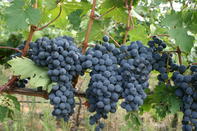Stellenbosch is Cabernet Sauvignon country. This red grape variety is the King of Grapes, producing some of the finest and most expensive wines in the world, such as in Bordeaux in France, especially on the Right Bank, and in the Napa Valley in the state of California in the USA.

But where else? Cabernet Sauvignon is often mentioned as an easy traveller, making good wines wherever it is planted. This is, however, misleading as great Cabernet needs very specific soils to produce great wines. In addition, it is a late ripening variety, demanding a long ripening season.
Styles of Cabernet Sauvignon
Cabernet Sauvignon is relatively new to South Africa, with single varietal bottlings rare, until the late 1970s, Alto and Zonnebloem Cabernet Sauvignon from the and 1960s notwithstanding. Kanonkop Cabernet was first bottled in 1973 and Meerlust in 1975. Before that, it was mostly used as part of a blend with Cinsault, Pinotage and possibly Tinta Barocca.
Today Stellenbosch is regarded as one of the best Cabernet Sauvignon terroirs in the world. The clay-rich soils of the Simonsberg and Helderberg applications are crucial. The 2018 launch of the Stellenbosch Cabernet Collective has made good work of this and will further drive this fine wine agenda. Working closely with the Stellenbosch Wine Route, the Collective is working to establish Stellenbosch’s claims as a prominent producer of South African Cabernet Sauvignon.
As a wine judge for the Prescient WineMag Cabernet Sauvignon Report since 2011, and many chairing opportunities for the Old Mutual Trophy Wine Show, it is clear to me that Stellenbosch Cabernet is just getting better and better. This is a crucial class for South African wines as these are wines able to age well and can be sold at a premium.
Besides being bottled as a single variety, Cabernet Sauvignon plays an extremely important role in South African signature blends. The first international 100 point score for a South African wine was for the Kanonkop Paul Sauer, which is usually 70% Cabernet-based.